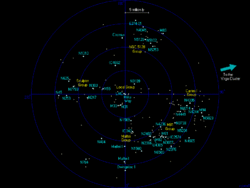Astronomy:Local Volume
| Known number of galaxies | 500[1] |
|---|---|
| Brightest member | Milky Way |
| Semi-major axis | 11 Mpc (35.9 million light years)[2] |
| Diameter | 22 Mpc (71.8 million light years) |
| Redshift | 0.00 (0 km/s) |
| Distance | 0 Mpc (0 million light years) |
The Local Volume is a collection of more than 500 galaxies located in an area of the observable universe near us, within a spherical region with a radius of 11 megaparsecs from Earth or up to a radial velocity of redshift of z < 0.002 (550 km/s).[3][4][5]
It was in this region of the universe where the Local Volume Legacy (LVL) project took place for the study of 258 galaxies through cycles of observations made by the Spitzer Space Telescope using the Infrared Array Camera (IRAC) and the Multiband Imaging Photometer (MIPS).[6][7][8][9]

This Local Volume study included all galaxies within a 3.5 megaparsec subvolume and a collection of spiral and irregular galaxies within 11 megaparsecs. The goals of the study were to collect data on the rate of star formation, stellar mass in old star populations, cosmic dust, and starlight interference.[10]
We can also define the Local Volume by the distance of 10 Mpc over which the Hubble Space Telescope can distinguish stellar populations in galaxies. This definition can be extended to 15 Mpc to cover a full range of galaxy environments, from voids to clusters and massive clusters. In the future, it should be possible to extend our definition of Local Volume to even greater distances.
Within the Local Volume is the Local Sheet, an area of flattened space containing about 60 galaxies that share the same velocity and is about 7 megaparsecs in radius and about 0.5 megaparsecs thick. The Local Group, of which the Milky Way and the Andromeda galaxy are part, is part of the Local Sheet and therefore, of the Local Volume. The Local Volume, in turn, is included in the Laniakea Supercluster.
Local Volume galaxies have a preferred movement called virgocentric flow, towards the Virgo cluster, caused by its overwhelming gravity.[11]
Among the member galaxies of the Local Volume, there are several large galaxies or particular galaxies such as Centaurus A, the Bode galaxy (M81), the Cigar galaxy (M82), the Circinus galaxy, the Southern Pinwheel galaxy (M83), the Pinwheel galaxy (M101), the Sombrero Galaxy (M104), NGC 1512, M51, M74, M66 and M96.[12]
Recently, following Hubble Space Telescope observations, two dwarf galaxies, Pisces A and Pisces B, have been identified as having migrated into the Local Volume from the neighboring Local Void.[13]
See also
References
- ↑ "Galaxies in the Local Volume". https://www.atnf.csiro.au/research/LVmeeting/.
- ↑ "Local Volume H i Survey (LVHIS) | Monthly Notices of the Royal Astronomical Society | Oxford Academic". https://academic.oup.com/mnras/article/478/2/1611/4898085.
- ↑ "Galaxy and Mass Assembly (GAMA): galaxies at the faint end of the Hα luminosity function | Monthly Notices of the Royal Astronomical Society | Oxford Academic". https://academic.oup.com/mnras/article/413/2/1236/1068584.
- ↑ "Galaxies in the Local Volume". https://www.atnf.csiro.au/research/LVmeeting/science_case.html.
- ↑ "Codex Cosmi". http://www.caelus.fi/CC/LocalVolume.shtml.
- ↑ Lee, J. C.; Kennicutt, R. C.; Engelbracht, C. W.; Calzetti, D.; Dale, D. A.; Gordon, K. D.; Dalcanton, J. J.; Skillman, E. et al. (2008-10-01). "The Local Volume Legacy Survey". Formation and Evolution of Galaxy Disks 396: 151. Bibcode: 2008ASPC..396..151L. https://ui.adsabs.harvard.edu/abs/2008ASPC..396..151L. Retrieved 2022-01-25.
- ↑ Kennicutt, Robert; Lee, J. C.; Engelbracht, C.; Begum, A.; Block, M.; Calzetti, D.; Dalcanton, J.; Dale, D. et al. (2007-12-01). "The Spitzer Local Volume Legacy". American Astronomical Society Meeting Abstracts 211: 95.02. Bibcode: 2007AAS...211.9502K. https://ui.adsabs.harvard.edu/abs/2007AAS...211.9502K. Retrieved 2022-01-25.
- ↑ Dale, D. A.; Cohen, S. A.; Johnson, L. C.; Schuster, M. D.; Calzetti, D.; Engelbracht, C. W.; de Paz, A. Gil; Kennicutt, R. C. et al. (2009-09-20). "The Spitzer Local Volume Legacy: Survey Description and Infrared Photometry". The Astrophysical Journal 703 (1): 517–556. doi:10.1088/0004-637X/703/1/517. ISSN 0004-637X. Bibcode: 2009ApJ...703..517D.
- ↑ "Spitzer Local Volume Legacy (LVL) SEDs and physical properties | Monthly Notices of the Royal Astronomical Society | Oxford Academic". https://academic.oup.com/mnras/article/445/1/899/1749609.
- ↑ Karachentsev, I. D.; Kaisina, E. I. (2019-05-21). "Dwarf Galaxies in the Local Volume". Astrophysical Bulletin 74 (2): 111–127. doi:10.1134/S1990341319020019. ISSN 1990-3413. Bibcode: 2019AstBu..74..111K.
- ↑ "CLoGS - The Complete Local-Volume Groups Sample". http://www.sr.bham.ac.uk/~ejos/CLoGS_Sample.html.
- ↑ "A Catalog of Neighboring Galaxies". https://www.researchgate.net/publication/231034583.
- ↑ "Hubble Uncovers a Galaxy Pair Coming in from the Wilderness". 2020-11-08. https://hubblesite.org/contents/news-releases/2016/news-2016-29.html.
External links
- Local Volume Legacy Survey | Institute of Astronomy
- How Far Away Is It - 12 - The Local Galaxy Volume (1080p) - YouTube
 |

